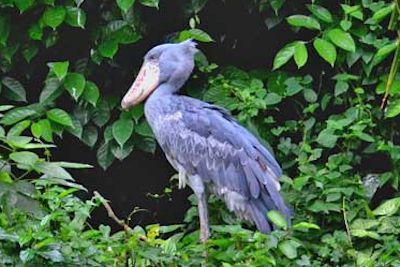 The shoe bill stork is also known as the whale head storks and scientifically called Balaeniceps rex. It gets its name after its big shoe shaped beak which is wide, long, colored and with a hooked tip. this bird worth seeing on a bird watching safari has a bill stork is a big bird therefore it’s a bit sluggish but has very strong legs, unwebbed feet and with broad as well as long wings which is why they are strong flyers. They can be seen both in the night and during day time because they are partially nocturnal birds. This bird is quite similar to the pelicans, the hamerkops and the herons in the way they fly.
The shoe bill stork is also known as the whale head storks and scientifically called Balaeniceps rex. It gets its name after its big shoe shaped beak which is wide, long, colored and with a hooked tip. this bird worth seeing on a bird watching safari has a bill stork is a big bird therefore it’s a bit sluggish but has very strong legs, unwebbed feet and with broad as well as long wings which is why they are strong flyers. They can be seen both in the night and during day time because they are partially nocturnal birds. This bird is quite similar to the pelicans, the hamerkops and the herons in the way they fly.
Where they are commonly seen
They are quiet birds and often live in isolation, that they only come together during the bad times of hunger when they are looking for food and also when it’s time for breeding.
Shoe bills are a lot more like water birds, they are commonly found near water, in places with swamps, wetlands and marshes. Their beaks are very useful while feeding as they feed on small crocodiles, the mud puddle fish, the lungfish, the frogs and other small water creatures when they surface in shallow water.
These birds are widely spread around the world, in Africa they are in different countries like Zambia, DRC, CAR, Rwanda, Ethiopia, among others and then in Uganda, you can find them in places like Mabamba wet land, national parks like Murchison falls, Queen Elizabeth, Bigodi swamp, Lake Mburo national park, the Uganda wildlife education centre and many more other places. This means that if you are planning a birding safari in Uganda, you can expect to see this bird though it’s not a guarantee.
Reproduction
The shoebill does the breeding during the dry season because during the rainy season, its eggs might flood while still in the nest and they get spoilt. They lay either one or two big flat and chalky white colored eggs that they keep in the nests made out of grass and then it is placed in a place they consider dry enough. Just like some of the other stork birds, they also pour some water over the nest so that they can keep their eggs cool. After hatching, the little birds stay in the nest for some time until they are grown enough to find food for themselves.
How they fly
While in flight, they hold their wings flat as they elevate in space and just as the case is with the pelicans and other stork birds of genus Leptoptilos, the shoebill stork also flies while the neck and head is bent backwards. It flaps its wings at a rate of about 150 flaps in a minute and it is considered among the slowest birds. They keep alternating the flapping pattern and gliding cycles at an interval of about 7 seconds each. When flushed, they will endeavor to fly but not farther than between 100 to 500 m away from the previous spot. It is very rare for it to cover a long distance in flight.
Threat to their survival
The only threat that these birds face is the destruction of their natural habitats by human activities since they are not illegally killed for any reason. Swamp encroachment and destruction of wetland threatens their survival since swamps and wetlands are where they find shelter. Shoe bill storks are among the most sought birds that every bird watcher is interested in seeing while on a birding safari.












